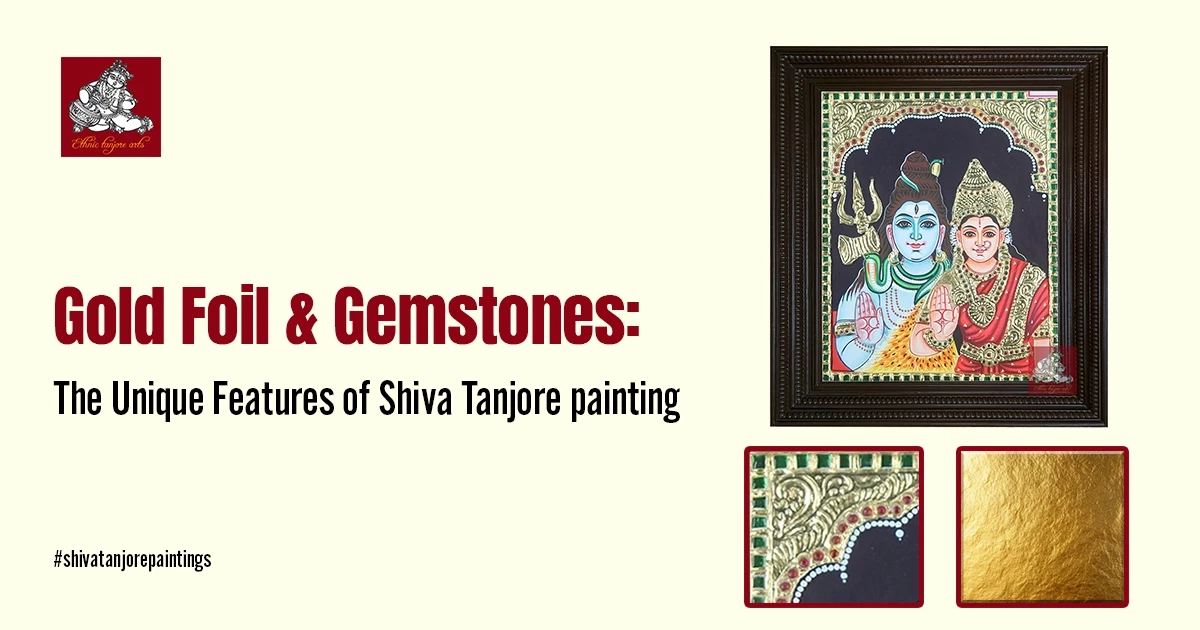Gold Foil & Gemstones: The Unique Features of Shiva Tanjore painting
Feb 5, 2025
Tanjore paintings are a beautiful and traditional form of art from South India. Among these, Shiva Tanjore paintings stand out due to their stunning use of gold foil and gemstones. Shiva painting is not just art; they are a representation of culture, spirituality, and craftsmanship. These paintings often depict Lord Shiva and Parvati , one of the most important deities in Hinduism. The vibrant colors, intricate designs, and the luxurious use of materials like gold foil and gemstones make these artworks truly special.
In this blog post, we will explore the unique features of shiva parvati paintings, focusing on why gold and gemstones are essential, how they are used, and the techniques involved in creating these masterpieces.
Why Gold?
Gold has been known across cultures for its beauty, rarity, and durability. In Tanjore paintings, especially those depicting Hindu deities like Lord Shiva and Parvati, gold serves many purposes:
Symbol of Divinity: Gold has always been a symbol of wealth, purity, and divinity. In Shiva Tanjore painting, gold is used to highlight the divine nature of Lord Shiva. These gemstones are carefully chosen and placed to highlight details in the artwork, like the delicate jewelry worn by deities.
Aesthetic Appeal: The gold foil adds a royal touch to the artwork, making it look luxurious and elegant. When light falls on the painting, the gold reflects it, creating a mesmerizing effect. The mix of bright colors and shining gold creates a striking contrast that defines this art style.
Cultural Significance: Historically, gold has been a symbol of wealth and prosperity in Indian society. The use of gold in Tanjore paintings represents wealth and divine blessings. Back then royalty and wealthy families often commissioned these artworks, reinforcing gold's importance in this art form.
How Gold Foil is Used in Tanjore Paintings
Gold is often used to outline figures, adorn clothing, and embellish jewelry worn by deities. The process of applying gold foil to a Shiva Tanjore painting is intricate and requires great skill.
First, the artist sketches the outline of Lord Shiva on a wooden board.
Then, a mixture of chalk powder and glue is applied to create a base.
Once the base is ready, thin sheets of gold foil are carefully placed on the painting.
Finally the gold foil is stuck to the areas where the mixture is applied, creating a shiny, 3D effect.
This technique is called embossing, which gives the painting a 3D look. This meticulous process requires skill and accuracy, as artists must make sure the gold enhances the bright colors without overpowering them.

One of the remarkable features of pure gold foil is that it not only enhances the beauty of the painting but also makes it durable. This makes them treasured pieces that can be passed down through generations.
The Elegance of Gemstones in Shiva Tanjore Paintings
Shiva paintings are a stunning blend of art, spirituality, and tradition. Apart from gold foil, gemstones are another unique feature of Shiva Tanjore painting. These precious stones are used to decorate the jewelry, clothing, and ornaments of Lord Shiva. They are carefully selected and placed within the artwork to create a dazzling effect that captivates viewers. The combination of gold foil and gemstones gives Tanjore paintings their unique charm, making them stand out among other art forms.
Why are Gemstones Used?
Gemstones play a crucial role in enhancing the beauty of paintings. They are not just decorative elements in Shiva parvati paintings; they have a deeper meaning. In Hindu culture, gemstones are believed to carry spiritual energy and divine power. They are carefully selected and placed within the artwork to create a dazzling effect that captivates viewers. The combination of gold foil and gemstones gives Tanjore paintings their unique charm, making them stand out among other art forms.
Aesthetic Appeal: The bright colors of gemstones bring depth and richness to the artwork. Paired with gold foil, they create a striking contrast that catches the eye. Each gemstone reflects light uniquely, adding a lively touch to the painting.
Symbolism: In Hindu culture, gemstones are believed to carry spiritual energy and divine power. For example, rubies symbolize love and passion, while emeralds represent harmony and balance. These stones in Shiva Parvati paintings express deeper spiritual meanings, which helps viewers connect with the themes of the artwork.
Cultural Heritage: The use of gemstones reflects traditional Indian artistry and craftsmanship. Skilled artisans carefully place each gemstone to highlight details like the jewelry worn by deities or decorative features in the painting.
Types of Gemstones Used
Artists use a variety of gemstones to decorate Tanjore paintings. Each stone is chosen for its color, meaning, and ability to enhance the painting’s beauty. Here are some of the most commonly used gemstones:
Ruby (Manikya)
Color: Deep red
Significance: Represents passion, power, and divine energy.
Use: Often used in the jewelry and ornaments of Lord Shiva in Shiva Parvati Paintings to symbolize his strength.
Emerald (Panna)
Color: Bright green
Significance: Symbolizes growth, harmony, and nature.
Use: Added to the clothing or background. Representing peace and balance, emeralds contribute a soothing green hue that complements other colors.
Sapphire (Neelam)
Color: Blue
Significance: Stands for wisdom, truth, and calmness.
Use: Placed in the crown or accessories of Lord Shiva. Symbolizing wisdom, sapphires enhance the regal appearance of deities depicted in the paintings.
Pearl (Moti)
Color: White or cream
Significance: Represents purity, peace, and prosperity.
Use: Used in necklaces or earrings to add a touch of elegance and serenity.
Topaz (Pushparagam)
Color: Yellow or golden
Significance: Symbolizes positivity and energy.
Use: Added to the background or borders to create a warm and vibrant effect.
Diamond (Heera)
Color: Clear or white
Significance: Represents clarity, strength, and eternity.
Use: Used sparingly to highlight important details, like the third eye of Lord Shiva.
Shiva Tanjore Painting Technique
Tanjore paintings are a celebrated form of Indian art, renowned for their intricate designs and vibrant colors. Among these, Shiva paintings hold a special place due to their spiritual significance and stunning craftsmanship. In this post, we will explore the unique features that make these artworks truly exceptional.
1. Use of Gold Foil
One of the most defining characteristics of Tanjore paintings is the use of 22-carat gold foil. This rich material is carefully added to different parts of the painting, creating a bright, eye-catching effect.. The gold foil not only enhances the visual appeal but also adds a layer of durability, ensuring that these artworks stay bright and stunning for years.
2. Incorporation of Gemstones
Shiva Tanjore paintings often feature semi-precious gemstones sourced from Jaipur. These gemstones are carefully chosen and placed to highlight details in the artwork, such as the intricate jewelry worn by Lord Shiva and other deities. The addition of gemstones adds depth and vibrancy, making each painting unique and captivating.
3. Traditional Materials
The materials used in Shiva paintings are of the highest quality and play a crucial role:
Chettinad Teak Wood: The frames are crafted from this durable wood, known for its strength and longevity.
Bright Paints: The vibrant colors used are designed to stand out and maintain their brilliance over time.
Chalk Powder Base: A smooth surface is created using chalk powder, which enhances the application of colors and gold foil.
4. Cultural Significance
Shiva is one of the principal deities in Hinduism, symbolizing creation, destruction, and regeneration. A Shiva painting serves not only as an artistic expression but also as a spiritual focal point for many devotees. It is believed that having such art in one’s home can bring peace, balance, and positive energy.
5. Artistic Techniques
The artistry involved in creating Tanjore paintings is remarkable:
Embossing: The combination of gold foil and gemstones creates a three-dimensional effect that adds texture and depth.
Layering Techniques: Many layers of paint are applied to achieve richness in color and detail.
If you’re interested in exploring beautiful Shiva Tanjore Paintings for your collection or home decor, consider visiting for exquisite options that embody these unique features.
Final Thoughts: A Timeless Treasure
Shiva Tanjore paintings are more than just decorative pieces; they embody rich cultural heritage and artistic excellence. The unique features such as gold foil and gemstones make them timeless treasures that can elevate any space. By understanding the significance of materials like gold and gemstones in Shiva paintings, we can appreciate not only their beauty but also their deeper meanings within Hindu culture.
If you’re interested in adding a piece to your collection or home decor, consider exploring Ethnic Tanjore Arts. Our collection features stunning artworks at an affordable price and is available online and at stores.

